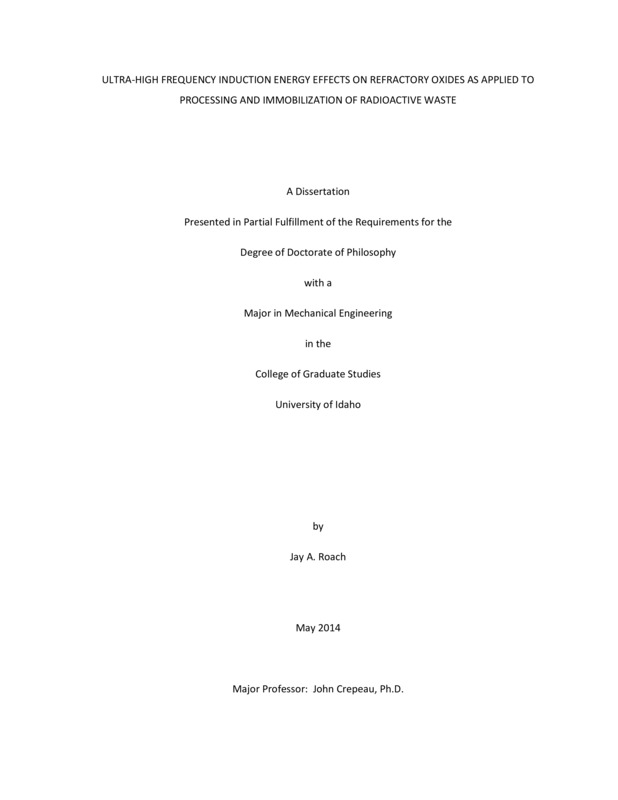ULTRA-HIGH FREQUENCY INDUCTION ENERGY EFFECTS ON REFRACTORY OXIDES AS APPLIED TO PROCESSING AND IMMOBILIZATION OF RADIOACTIVE WASTE
Roach, Jay A.. (2014). ULTRA-HIGH FREQUENCY INDUCTION ENERGY EFFECTS ON REFRACTORY OXIDES AS APPLIED TO PROCESSING AND IMMOBILIZATION OF RADIOACTIVE WASTE. Theses and Dissertations Collection, University of Idaho Library Digital Collections. https://www.lib.uidaho.edu/digital/etd/items/roach_idaho_0089e_10252.html
- Title:
- ULTRA-HIGH FREQUENCY INDUCTION ENERGY EFFECTS ON REFRACTORY OXIDES AS APPLIED TO PROCESSING AND IMMOBILIZATION OF RADIOACTIVE WASTE
- Author:
- Roach, Jay A.
- Date:
- 2014
- Keywords:
- high frequency induction melting refractory oxides
- Program:
- Mechanical Engineering
- Subject Category:
- Mechanical engineering
- Abstract:
-
The application of ultra-high frequency induction melting of refractory oxides (i.e. borosilicate glass [BSG]) has been extensively investigated to determine the feasibility of developing and implementing an innovative inductively heated draining technique that is reliable and predictable. The primary purpose is for immobilizing highly radioactive waste streams resulting from reprocessing of spent nuclear fuel. This work has included development and validation of a numerical model, using ANSYS MultiPhysics software, as well as numerous proof-of-concept and pilot-scale experimental tests.
The model is a steady state axially-symmetric geometry for a cylindrical water-cooled crucible that includes two separate induction energy sources operating at different frequencies. It accounts for the induction energy interactions, thermal conduction, convection, and radiation effects, as well as hydrodynamic phenomenon due to buoyancy effects. The material property models incorporated into the numerical model include temperature dependence up to 2,000oC of key parameters including density, specific heat, thermal conductivity, and electrical conductivity, which can vary by several orders of magnitude within the temperature variations seen. The model has been experimentally validated, and shown to provide excellent representation of steady state temperature distributions, convection cell configurations, and flow field velocities for molten low conductivity materials. Thus, it provides the capability to conduct parametric studies to understand operational sensitivities and geometry effects that determine the performance of the inductively heated draining device, including scale-up effects.
Complementary experimental work has also been conducted to test the model predictions, and iteratively used to improve the model accuracy. However, the primary focus of the experimental efforts was to demonstrate the feasibility of the inductively heated draining technique for application to immobilization of radioactive waste in a BSG. Proof-of-concept experiments were conducted demonstrating the ability to induce sufficient energy into a miniaturized geometry such that melting will occur using an ultra-high frequency (i.e. 30 megahertz [MHz] range as compared to normal operations in the 250 kilohertz [kHz] to 2 MHz range). Exhaustive pilot-scale experiments were also conducted to evaluate the operation of the various inductively heated drain devices that were designed and implemented into large diameter (i.e. 300 and 400 mm) cold crucible induction melter systems.
- Description:
- doctoral, Ph.D., Mechanical Engineering -- University of Idaho - College of Graduate Studies, 2014
- Major Professor:
- Crepeau, John
- Committee:
- Cordon, Daniel; Siahpush, Ali; Utikgar, Vivek
- Defense Date:
- 2014
- Identifier:
- Roach_idaho_0089E_10252
- Type:
- Text
- Format Original:
- Format:
- application/pdf
- Rights:
- In Copyright - Educational Use Permitted. For more information, please contact University of Idaho Library Special Collections and Archives Department at libspec@uidaho.edu.
- Standardized Rights:
- http://rightsstatements.org/vocab/InC-EDU/1.0/

